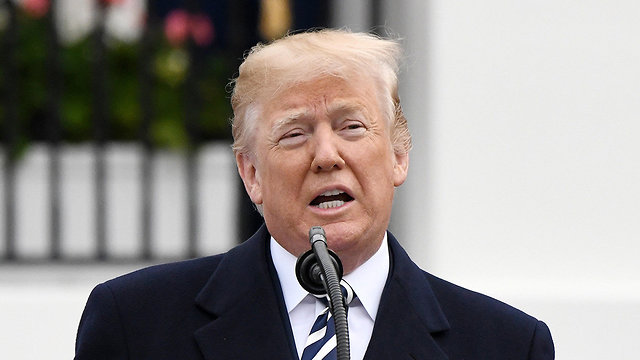
Iranian rial
צילום: רויטרס
Iran rial near record lows as Trump decision on nuclear deal looms
Iranian currency driven down by heavy demand for dollars among Iranians who fear resumption of US sanctions that would constrict Tehran's foreign trade; Iran's central bank governor insists economy would not be affected by a US withdrawal from nuclear deal.
DUBAI - Iran's rial traded near record lows against the dollar in the free market on Tuesday as Iranians tried to buy hard currency, fearing economic turmoil if US President Donald Trump withdraws from a deal on Iran's nuclear program.
The dollar was selling for 65,000 rials, according to foreign exchange website Bonbast.com, which tracks the free market. That was down from 57,500 at the end of last month and 42,890 at the end of last year.
Economists inside and outside the country said the rial was being driven down by heavy demand for dollars among Iranians who feared a US pullout from the nuclear agreement would lead to the resumption of US sanctions against Tehran, deterring other nations in Europe and Asia from developing business ties. This could constrict Iran's foreign trade, causing a spike of inflation and further reducing access to hard currency in an economy which is already struggling with high unemployment and the threat of a crisis among financially troubled banks.
Mehrdad Emadi, an Iranian economist who heads energy risk analysis at London's Betamatrix consultancy, said the approach of Trump's decision was encouraging a mass flight out of the rial. On Sunday, the currency hit a record low of 67,800.
"This large scale de-rialization of the Iranian economy has now created a complete collapse of confidence," Emadi said, adding that if the government did not take immediate steps to shore up the banking system and restore business confidence, the currency could fall as low as 110,000.
"Such a rate would translate to a tripling of the inflation rate and a deep dollarization of the Iranian economy, and barter-based transaction when hard currency cannot be found."
Trump said he would announce at 2pm on Tuesday whether he would withdraw from the nuclear deal, which eased international sanctions on Iran in exchange for Tehran limiting its atomic program.
A senior US official said it was unclear if efforts by European allies to address Trump's concerns would be enough to save the pact, but European diplomats said privately they expected Trump to effectively withdraw from the agreement.
As pressure on the rial mounted in early April, Iranian authorities tried to halt its slide by saying they were unifying official and free-market exchange rates at a single level of 42,000, and banning any trade at other rates.
People who violated the ban were threatened with arrest. The strategy failed to stamp out the free market, however, because demand for dollars far exceeds limited supplies that authorities have provided through formal channels at the official rate.
"The free market has been shut down officially, but it continues its work unofficially. There is an underground currency market in Iran, with rates, charts and everything," said an analyst in Tehran, declining to be named for legal reasons.
"Instead of stopping by at the exchange shop, people arrange their trade by phone calls and through underground channels."
As part of its crackdown, Iran clamped a 10,000-euro ($11,900) ceiling on the amount of foreign currency that citizens can hold outside banks.
The Tehran analyst said this regulation was being widely disobeyed, and estimated billions of dollars were being held illicitly outside banks.
"The real dollar rate is much higher, and people know from the past that when they deposited their dollars into bank accounts, they were not able to withdraw later."
Publicly, Iranian officials have blamed the rial's weakness on a plot by the United States and other nations. But the turmoil has had political repercussions in Tehran, where members of parliament have demanded the resignation of central bank governor Valiollah Seif.
Seif said on Tuesday the country's economy would not be affected by a US withdrawal from the agreement.
"We are prepared for all scenarios. If America pulls out of the deal, our economy will not be impacted," he said on state television.
The government was already under fire over its management of the economy. In January, public protests over corruption and economic hardship were crushed by the authorities and at least 25 people were killed.
Iran is running a substantial current account surplus, according to the International Monetary Fund, which estimates the government's foreign assets and reserves at $112 billion.
With oil prices at multi-year highs, that may give Tehran enough firepower to prevent any collapse of the rial, if it chooses to satisfy the demand for hard currency and flood the free market with dollars.
But official economic data in Iran can be inaccurate, and some private economists estimate the amount of reserves which Tehran can easily access is much lower.
In March, the semi-official ISNA News Agency quoted Mohammad Reza Pourebrahimi, head of the economic committee in Iran's parliament, as saying Iran had suffered capital outflows of $30 billion over four months.














